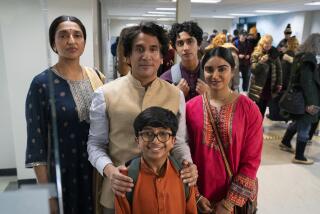A kids’ world, odd and true
In a town of no fixed geography called Wellsville (motto: “Come back when you have a minute”), situated somewhere in “The Sideburn State,” a four-hour run (carrying bowling ball) from the Canadian border, 500 miles from Hoover Dam and not far from the beach, live two brothers named Pete, along with bigger Pete’s best friend, Ellen; their “personal superhero” Artie the Strongest Man in the World; their father, Don; their mother, Joyce; and the metal plate in Joyce’s head.
More specifically, they live in “The Adventures of Pete & Pete,” a show that ran from 1990 to 1995 on Nickelodeon, first as minute-long promotional pieces meant to reflect a certain bright surrealism back on the network, then as a handful of half-hour specials, and finally for three seasons as a proper series. The first season has just been released on DVD, along with most of the specials and a couple of the spots, and it is as good as television has ever been and great in ways few shows ever attempt.
Created by Will McRobb and Chris Viscardi and developed with director Katherine Dieckmann, it is a children’s show, ostensibly. But like most of the best things made for children, it wasn’t made for children alone. It’s not that certain jokes or references have been slipped in for the grown-ups, like a shot of gin in a glass of milk -- though there are definitely things here that will fly over the head of any child not conversant, say, with tales of 1920s Paris, or Bob Dylan’s “Subterranean Homesick Blues” film. It’s rather that in trying to express the hilarious poetic essence of life, Team Pete made something universal.
Viscardi and McRobb’s quixotic vision for the show was that it be “funny, sad, strange and beautiful,” as they put it by telephone. A lot of TV shows strive to be funny, and plenty are, but the other qualities are more elusive. Strangeness is not the same thing as weirdness, or wackiness, which is what television more often wants to sell you. Beauty is not the same thing as prettiness. And though TV revels in tragedy, sadness is different: more pervasive, more delicate and delicious, and usually seen as something to cure rather than -- as it is here -- something possibly to cultivate.
“I think at the heart of a lot of the episodes is a feeling of wistfulness,” McRobb said, “whether it be the summer ending, or saying goodbye to somebody. There’s this feeling of loss.” (Although, he added, “Like any good R.E.M. song, we would undercut the sentimentality with a lot of mumbling.” ) The show’s ripeness-is-all atmosphere is enhanced by its setting -- various towns in northern New Jersey -- and the way it responds to the seasons, green in the summer, orange in the fall, gray in winter. “On the surface, there’s something very normal about New Jersey,” said McRobb, who spent some of his childhood there, “but under the surface, there’s something very twisted about it. It’s like in ‘Blue Velvet’ -- there’s always an ear somewhere in the grass.”
They were out to put mystery back into the world. “Everything on TV is so overexplained -- for adults and especially for kids,” McRobb said. “We wanted a sort of folkloric look at the suburbs, where things weren’t always able to be clearly explained -- the idea being at that age maybe you don’t care so much.” It’s never said why Pete and Pete (Michael Maronna and Danny Tamberelli, in decreasing order of size and age, and wide-eyed and cunning, respectively) are both named Pete or why young Pete has a tattoo on his arm of a lady in a red dress he sometimes encourages to “Dance, senorita, dance.” (Her name is Petunia and she gets her own credit in the opening titles, as does the plate in Mom’s head).
Ideas that elsewhere in television might have driven an episode of “The Wonder Years” were given, in Viscardi’s words, a “mythic spin,” a “tall-tale feel.” There’s a liberal use of dramatic constructions such as “Once upon a time” and “Some say” -- as in, “Some say he possessed the secrets of the universe -- all we knew is that he used to fix dishwashers for a living” to introduce the boys’ grandfather. Such words as “destiny,” “fate,” “legendary” and “sacred” are applied to the stuff of daily life, elevating the mundane to the metaphysical. There are frequent references to the stars, and to the wonders of science, often as metaphors for deepest human feelings -- as when big Pete longs for someone “to set my heart spinning like a broken compass.”
Shop class becomes an exercise in terror; sibling rivalry escalates into a PR war, with paid announcements and a cameo from John McLaughlin. Little Pete stays up 11 days past his bedtime. In this world, a dodgeball game might curiously resemble the American Revolution, your math teacher might play bass in your band, a metal detector might uncover a car buried at the beach. (“We all pitched in,” said Big Pete, “and within the hour we were the proud owners of a 1978 Cutlass Supreme. It ran perfectly and had tons of legroom.”)
“We were a bunch of children out in a field with a big paint box,” Dieckmann said of making the show. She and McRobb and Viscardi had the advantage of their own inexperience -- they didn’t know what they couldn’t do, and so they went ahead and did it. Dieckmann, who had gone to high school with McRobb in upstate New York and serendipitously met him again at a reunion just before “Pete” went into production, had directed only the R.E.M. video “Stand” but was a “geeky film-head” and journalist. The show’s soundtrack, with its abruptly swerving stock musical cues, she said, was inspired by Jean-Luc Godard.
The nearest influence on the show, however, was the era’s indie rock and film scenes, which were still markedly regional and turning limited means into high style. They borrowed cast and crew, including cinematographer Michael Spiller, from director Hal Hartley (“Simple Men”). “Pete” directors included Maggie Greenwald (“The Ballad of Little Jo”), Alison Maclean (“Jesus’ Son”) and Peter Lauer, who would later work on “Malcolm in the Middle,” “Ed” and “Wonderfalls” -- grown-up series with something of the “Pete” spirit. And the soundtrack featured music by Yo La Tengo, the Magnetic Fields and Apples in Stereo, and especially by the Connecticut-based Miracle Legion (masquerading as Polaris), which performs the show’s hard-to-decipher theme on the Petes’ front lawn.
“We have this term ‘ragged glory,’ ” said McRobb, “and it was what we liked best about our favorite songs -- that low-fi sensibility, where if you can get the emotions down, it doesn’t really matter so much how it’s recorded. The series is a little bit infused with that feeling: a lot of emotion, a lot of stops and starts, it’s catchy, you don’t quite understand all the lyrics, but the ones that you do remember stick with you. It was an attempt to give you that kind of chill that a certain kind of music does.”
*
Familiar faces abounded
Musicians and indie-world actors also made frequent acting cameos, mostly as civil servants -- mail carriers (Ann Magnuson, Bebe Neuwirth), school bus drivers (Damian Young, Ellen Cleghorne), crossing guard (Martin Donovan), forest ranger (David Johansen), schoolteachers (Violent Femmes’ Gordon Gano, Janeane Garofalo, LL Cool J, Syd Straw), cafeteria lady (Juliana Hatfield), janitor (Richard Edson), meter men (Chris Elliott, Marshall Crenshaw), ice cream man (Michael Stipe) -- and also as neighbors (Steve Buscemi, Iggy Pop, Debbie Harry).
Toby Huss (late of “Carnivale”) was a performance artist pulled from the East Village to play funk-mad superhero Artie, “the final piece in the ‘Pete & Pete’ puzzle,” said McRobb, and at the same time, according to Viscardi, “a polarizing element. A lot of the executives really did not like him, they just thought he was disturbing -- a grown man walking around in pajamas and wingtips. But we liked that it actually kept them a little off balance.” Little Pete was also a lightning rod for parental umbrage, on account of his aggressive language -- “Suck chowder, jerkwood,” “Deal with it, dipwad,” “No comment, grungeback,” or (addressing his father) “Cut to the chase, squirmy,” are typical Little Pete-isms -- and his general disrespect for authority.
It wasn’t outrage that brought the show to an end, however, so much as its uncategorizable oddness, its aging cast, and the simple fact that in Wellsville as elsewhere, there is a season, turn, turn, turn. And it did make its mark: Dieckmann teaches screenwriting at Columbia now, “and a lot of my students saw the show when they were kids, and as soon as I tell them I did ‘Pete & Pete’ it’s like Jesus has walked into the room.” Viscardi and McRobb -- who went on to create Nickelodeon’s animated omnibus “Kablam!,” have just finished a script for “Triplets of Belleville” director Sylvain Chomet and are even now working on a new Nickelodeon pilot, kids -- had a similar experience not long ago, speaking to film students at Syracuse University, their common alma mater: They outdrew Stephen King.
More to Read
The complete guide to home viewing
Get Screen Gab for everything about the TV shows and streaming movies everyone’s talking about.
You may occasionally receive promotional content from the Los Angeles Times.







